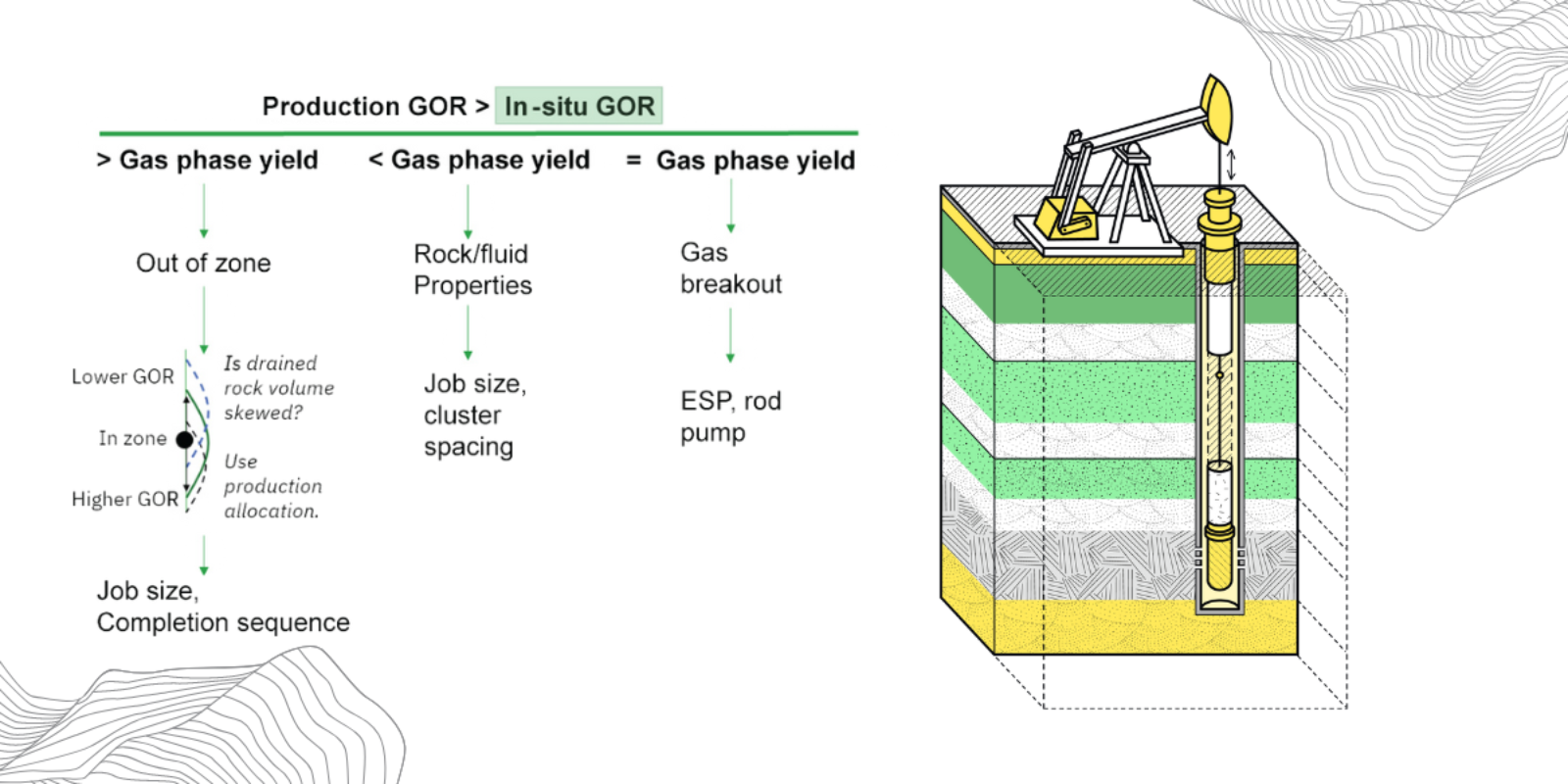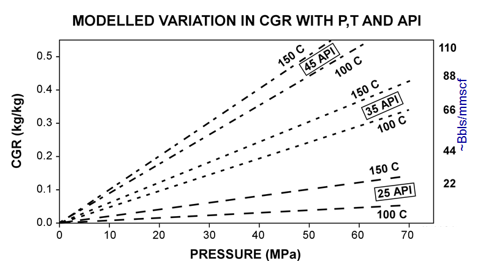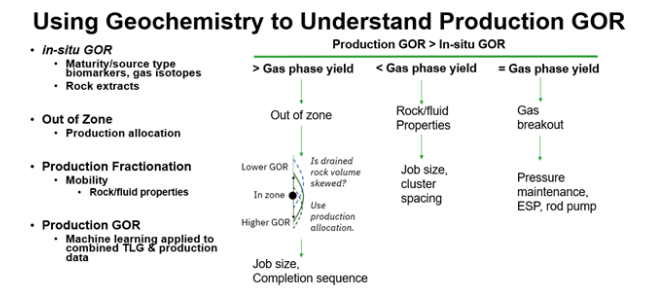Using Geochemistry to Understand Production GOR in Unconventional Reservoirs

Introduction
It is interesting that the collection of production fluids is not done more routinely in the industry to understand production physics in tight reservoirs. Historically, most geochemistry has been done in the context of stamp collecting to describe oil families, oil maturity or a petroleum system, but not really integrated with the physics of fluid migration. With the advent of modern conventional reservoir geochemistry, many operators started to introduce physics of fluid flow and impact of reservoir parameters (porosity and permeability) on to the stamp collecting reservoir geochemistry. So called evaporative fractionation was recognized as a geologic migration event, and even used to help with exploration. With the advent of unconventional reservoirs, fluid chemistry again presents a unique opportunity to integrate with physics to understand what is controlling production GORs by area or at the pad level in unconventional tight reservoirs.
At a high-level view, production GOR is controlled by either fluid PVT (e.g., Larter and Mills, 1991) or geologic controls. Geologic controls are commonly one or more dominated by source rock type or thermal maturity, or stratigraphy. The fluid PVT controls can be either implemented at the geologic time frame (i.e., vertical or lateral migration of fluids or rock strata) or the production time frame. In the event of conventional reservoirs with higher permeability (>0.01 md), production time frame fluid fractionation is not observed or minor. However, for unconventional tight reservoirs at nanodarcy permeability, production fractionation will occur (Whitson, 2012).
In this technical note we will explore how information from fluids combined with reservoir engineering can be used to understand mechanisms and be incorporated into predictive models. Depending on what is controlling the production GOR, different action items may be possible by the operator. Operational changes may incorporate changes in completion job size, cluster spacing, development sequence or production style (e.g., pressure management, ESP, rod pump).
Resource Type (migrated or in-situ)
Geochemistry’s first application is to establish if the resource play is a hybrid migrated (miles+) play or an in-situ local sourced (< 0.5 km) play with minimal fluid migration. This is established by looking at rock thermal maturity (e.g., Tmax, measured %Ro) versus fluid thermal maturity (e.g., biomarkers, stable isotopes). In the event fluid maturity is greater than rock maturity (migrated play), the fluids maturity may be broken down into further boiling point classes (gases, gasoline range, C15+) in order to determine if multiple migration events have occurred.
Geologic Time Frame Fractionation
Petroleum oil and gas will fractionate on primary migration from source rock intervals to non-reservoir intervals (Song et al., 2022, Tinni et al., 2018). The differences in rock properties combined with fluid properties sets up the context for variable fluid mobility in vertical sequences. In this discussion mobility is defined as the ratio of permeability to in-situ reservoir viscosity. Depending on the stratigraphy, the vertical variability in mobility can be substantial. This results in some intervals as contributors and others as non-contributors during production or at least until late-stage pressure draw down. This initial variability in fluid mobility can be identified with core canister desorption information to understand changes in GOR that control viscosity. A less expensive method is to use the rock extracts and derive dead oil API gravity to look for gradients in density. In the case of local source charge, extract GC molar slope analysis can often be translated into GOR (Jarvie and Weldon, 2015 and reference therein).
In-situ GOR (IP)
In-situ GOR is often one of the most poorly know variables but is important to understand production GOR controls. Simple fluid (dead oil, flashed gas, mudgas isotopes) geochemistry can be used to derive information on fluid thermal maturity and source rock type. The fluid maturity and source rock organic facies will constrain the likely range for in-situ GOR. Other methods such as mudgas ratios and core canister desorption can be used to help constrain the initial GOR. Even extrapolation of the production GOR in a Horner type plot method to initial time is valuable for derivation of the initial GOR.
Production GOR v. In-situ GOR
The first comparison to make is what is the production GOR relative to the in-situ GOR. The extent of the difference between the two is commonly a function of reservoir permeability and fluid properties that define the mobility (permeability/viscosity). The production and in-situ GOR will commonly be close to parity at permeability >0.1 md but become significantly different at tight reservoirs near 0.0001 md. A large part of the difference in the GOR is driven by methane mobility relative to other hydrocarbons. At lower permeabilities, diffusion becomes a larger proportion of the total flux of methane on production (Tinni et al., 2018). This can be measured in many unconventional plays by offset of methane and ethane stable carbon isotope to progressively more negative isotopes than expected for fluids of the same maturity in conventional reservoirs. For example, in the Middle Bakken plays (>0.01 md), the delta offset is minor, but for the Eagleford Shale (<0.001 md), delta offset can be 5+ per mil or more. This fractionation of components is also influenced by the total organic carbon content, where higher TOC (7.2 wt.%) is found to cause fractionation preferential to low TOC (1.3 wt.%).
Production GOR v. Gas Phase Yield
The gas phase yield is the amount of condensate that can be produced with a gas at the respective oil density, temperature and pressure, Figure 1 (England et al., 1991, England 2002). Reservoirs that break out gas and produce gas predominately due to mobility should be expected to have yields matching the gas phase yield. If the production GOR is higher than the gas phase yield, then excess gas is coming into the system. This could be due to drainage of additional gas intervals, above or below the landing target. The use of production allocation to understand drainage height is useful to understand where the extra gas is derived.

Figure 1 - Gas phase yield as a function of pressure, temperature, and oil density.
Production Fractionation at Molecular Level
Production fractionation is commonly observed by bulk fluid property changes. The API gravity increases and ratio of saturate to aromatic compounds increases. The molecular scale levels of change are often not recognized even when using time lapse geochemistry (TLG) because the changes occur so quickly.
When we produce an oil reservoir, we are effectively conducting a differential liberation PVT experiment at isothermal, and reducing pressure (van Graas, 2000).
Molecular level changes and magnitude of phase fractionation effects will depend on the actual temperature and pressure of the system (in addition to the composition and relative amounts of all phases). However, molecular level changes in produced fluids record a host of physics (e.g., diffusion, desorption, fluid phase partition coefficients, fluid-rock interaction) that occurs on production that can be correlated to useful engineering production metrics such as GOR, water cut or even flow assurance issues such as wax precipitation (Song and Michael, 2021, Freeman et al., 2012). The ability to harness these molecular level changes for production metrics requires combining production data with simple geochemistry (e.g., whole oil gas chromatography) and using machine learning to build predictive models. The predictive models can then be used on data/samples already being collected for tracer or production allocation studies in field development for additional support in GOR prediction along side decline curve analysis, plan water handling facilities or production monitoring for flow assurance to identify problem wells (wax, H2S).

Figure 2 – Summary of workflows comparing production GOR to in-situ GOR and gas phase GOR to understand main controls on production GOR. The geochemistry toolbox is incorporated in multiple areas to understand and quantify the controls which in lead to changes in development strategy.
Conclusions
In summary, geochemistry offers a tool to understand controls on production GOR from tight reservoirs. Geochemistry helps to establish the initial in-situ GOR for comparison to production GOR and subsequently can be used to quantify out of zone contributions via production allocation or used to build predictive models to understand long term yields. Without collection of production fluids, we are left with a limited data set to inform on the physics that control yields.
Acknowledgments: Thanks to Eric Michael of APT USA whose comments are gratefully acknowledged.
If you're interested in learning more, click here to read previously published technical notes covering: Reservoir filling: implications for reservoir geochemistry.
References
England W. A., Andrews S. R., and Ruckheim J. 1991. Experimental simulation of gas-phase migration: results and interpretations. Organic Geochemistry, Advances and Applications in Energy and Natural Environment. 15th Meeting of the European Association of Organic Geochemists Poster Abstracts, p. 146-150.
England 2002. Empirical correlations to predict gas/gas condensate phase behavior in sedimentary basins, Organic Geochemistry, v. 33, 665-673.
Freeman, M. C., Moridis, J. G., Michael, E., and Blasingame, A. T. 2012. Measurements, modelling, and diagnostic of flowing gas composition changes in shale gas wells. Presented at the SPE Latin America and Caribbean Petroleum Engineering Conference, Mexico City, Mexico, 16-18 April. SPE 153391.
Jarvie D.M., and Weldon D., 2015. Geochemical assessment of in situ petroleum in unconventional resource systems. URTeC 2173379.
Larter S. and Mills N., 1991. Phase-controlled molecular fractionations in migrating petroleum charges. Geological Society Special Publications No. 59, 137-147.
Song, Y., Michael E., McLin K., Mahlstedt N., Horsfield B., Potz S., Mangelsdorf K., 2022. Compositional Fractionation of Petroleum Fluids During Migration and Production: A Bakken Case Study with Fourier Transform Ion Cyclotron Resonance (FT-ICR) Mass Spectrometry, URTeC 3722153
Song Y. and Michael E., 2021. Production Diagnostics with Time Lapse Geochemistry. URTeC 5398
Tinni A. Perez F., Devegowda D., Truong T. Dang S. Sondergeld C. And Rai C. (2018) In-situ fractionation in liquids-rich shales and its implications for EOR: Experimental verification and Modeling Study. URTeC 2902946.
Van Graas G.W., Gilje A.E., Isom T.P. and Tau A.L. 2000. The effects of phase fractionation on the composition of oils, condensates and gases. Org. Geochem. 31, 1419-1439.
Whitson C.H. and Sunjerga S. 2012. PVT in liquid-rich shale reservoirs. SPE 155499
